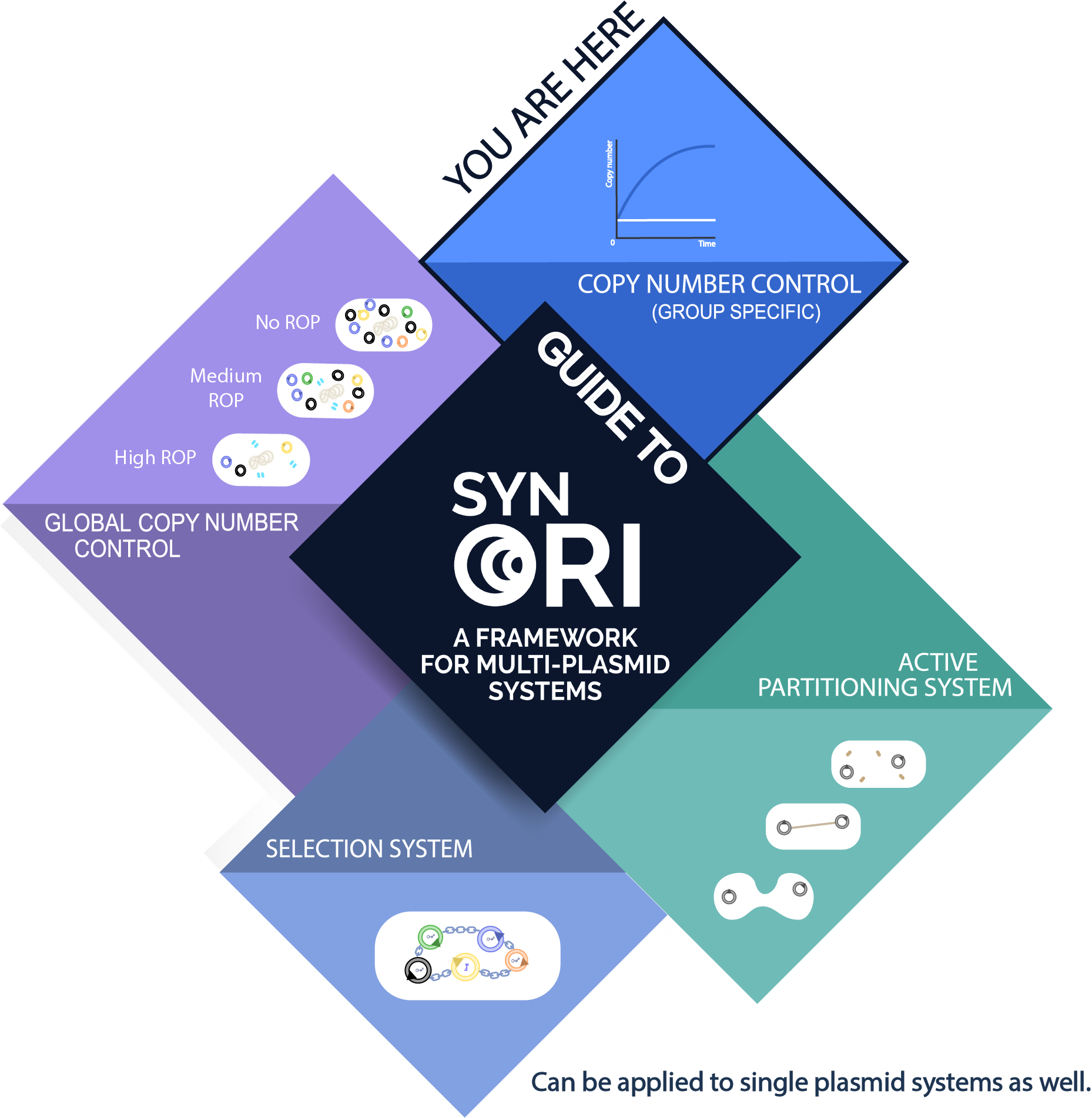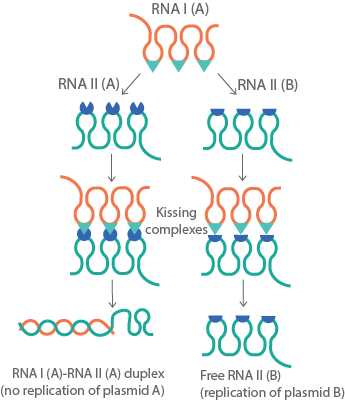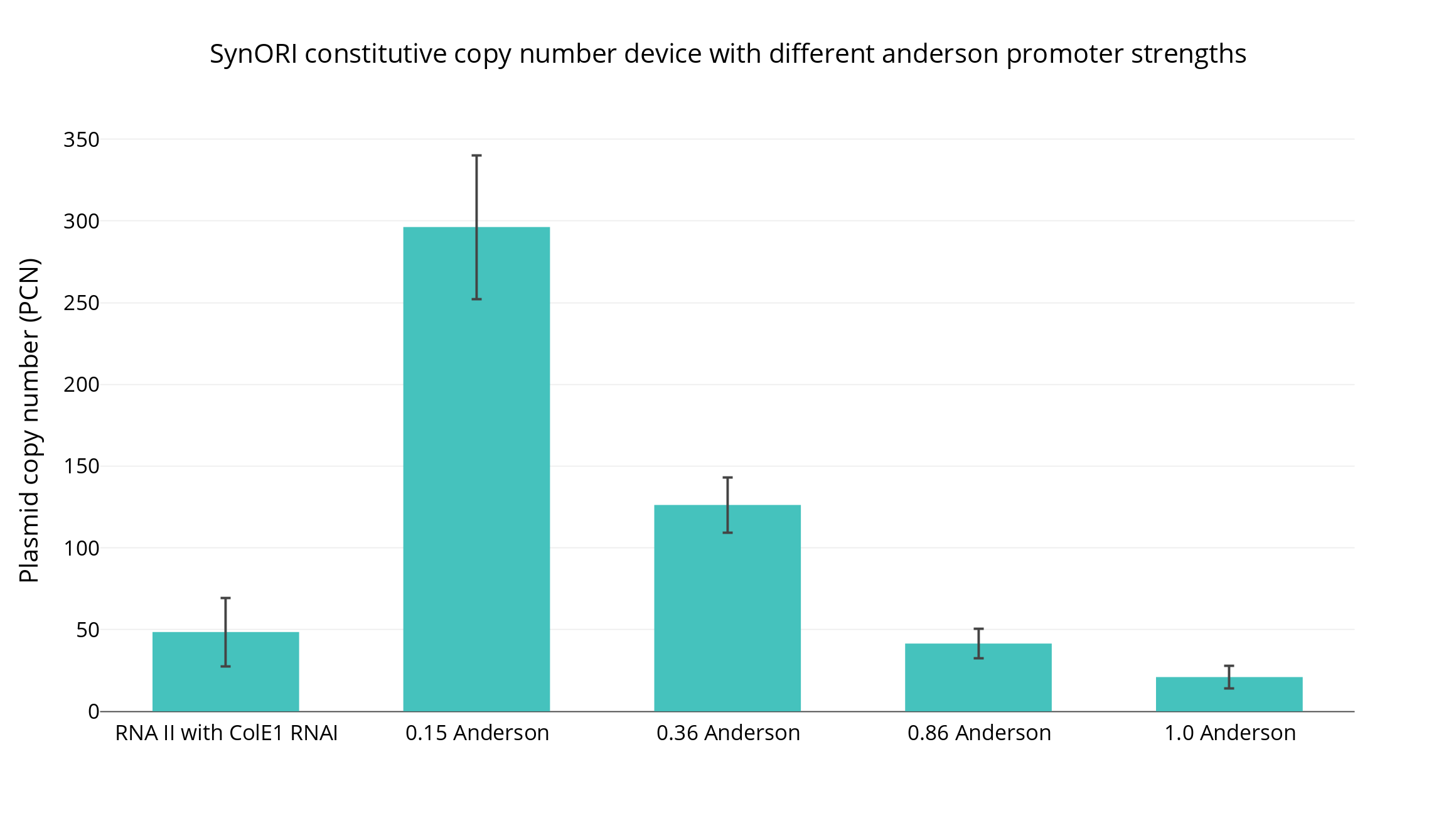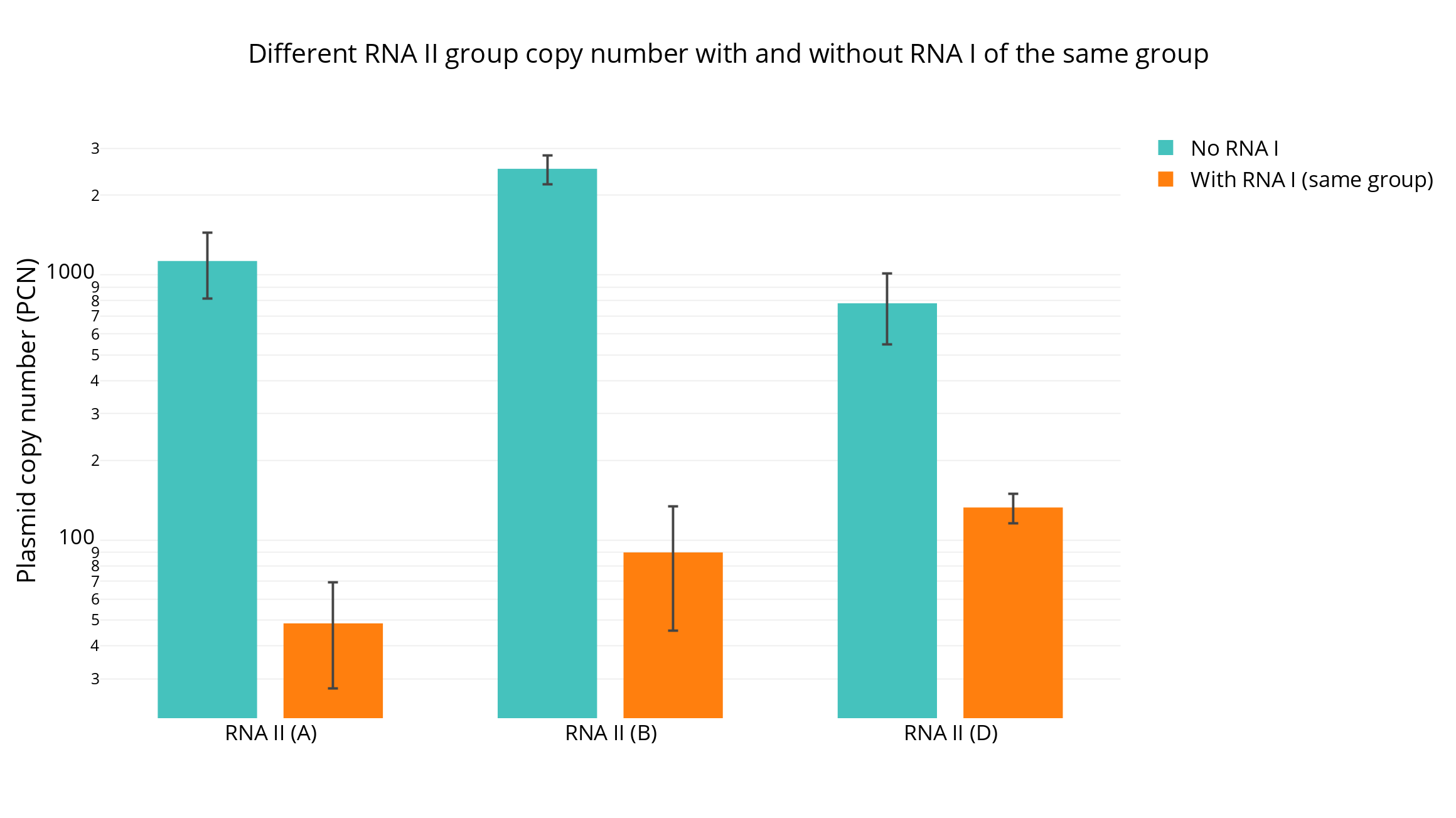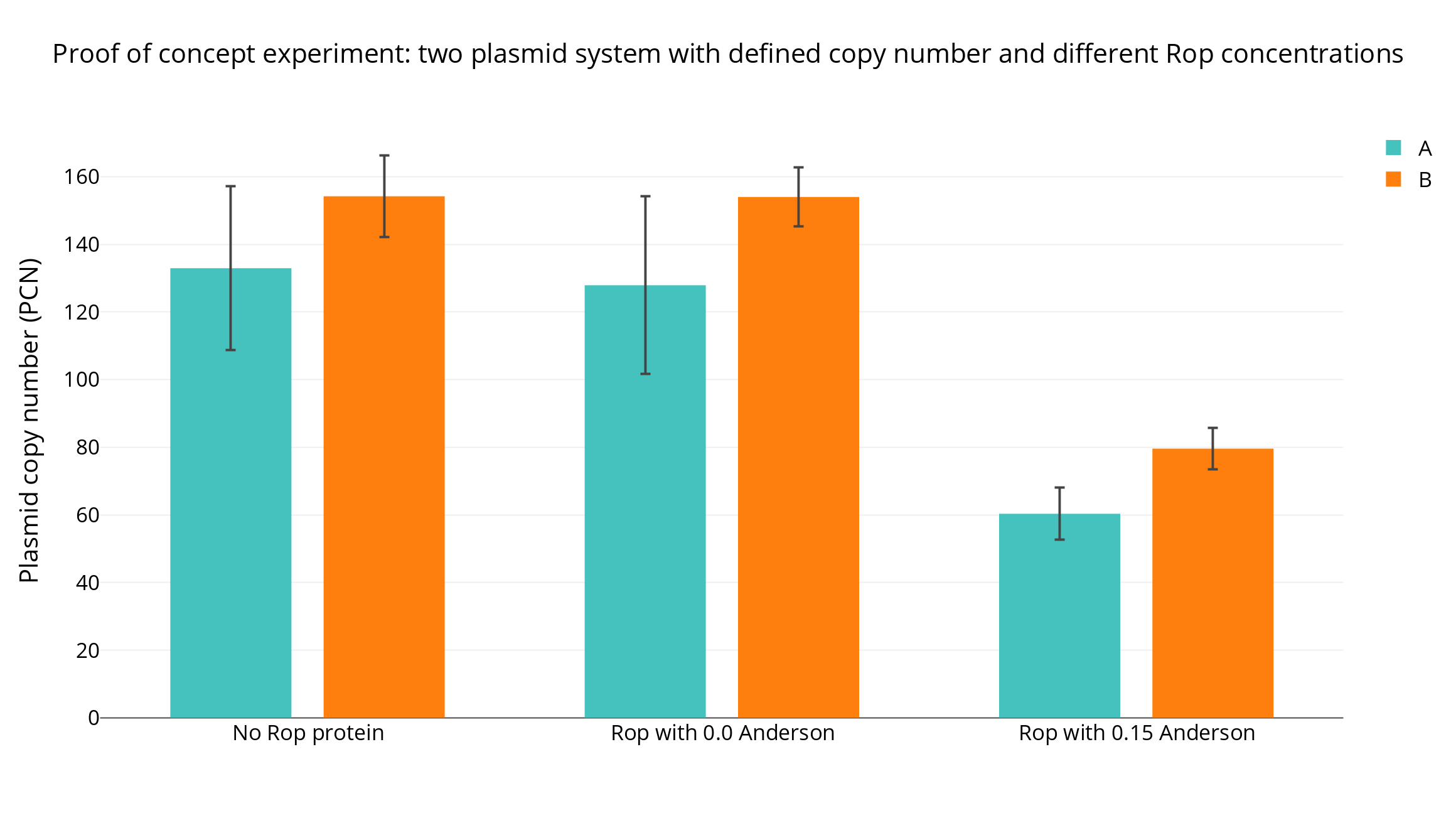Part:BBa_K2259025
SynORI framework RNA I - Plasmid replication Inhibitor (Group B-NC)
RNA I acts as a plasmid replication inhibitor. RNA I gene transcript's secondary structures, which consists of three stem loops, binds to RNA II (replication initiator) secondary structures and - if successful - inhibits plasmid replication initiation. Every SynORI RNA I part has its wildtype promoter removed, and consequently, RNA I can be placed under any promoter signal pattern desired (Part:BBa_K2259086 is an exception, it is a fully wild type RNA I gene combined with wild type promoter).
- Caution! RNA I (Group B) indicates that this plasmid only interacts with the replication initiator RNA II (Group B) Part:BBa_K2259001 from SynORI (framework for multi-plasmid systems) collection and is stable when placed with other SynORI plasmid groups. RNA II B will not be regulated with RNA I from another group!
See how this part fits into the whole SynORI framework by pressing here!
Sequence and Features
- 10COMPATIBLE WITH RFC[10]
- 12COMPATIBLE WITH RFC[12]
- 21COMPATIBLE WITH RFC[21]
- 23COMPATIBLE WITH RFC[23]
- 25COMPATIBLE WITH RFC[25]
- 1000COMPATIBLE WITH RFC[1000]
Introduction
Biology
ColE1 plasmid replication overview
ColE1-type plasmid replication begins with the synthesis of plasmid encoded RNA II (also called primer transcript) by RNA polymerase which initiates transcription at a site 555bp upstream of origin of replication. The RNA transcript forms a RNA - DNA hybrid with template DNA near the origin of replication. Hybridized RNA is then cleaved at the replication origin by RNAse H and serves as a primer for DNA synthesis by DNA polymerase I (Figure 1. A).[1]
Initiation of replication can be inhibited by plasmid encoded small RNA, called RNA I . Synthesis of RNA I starts 445 bp upstream of the replication origin and proceeds in the direction opposite to that of RNA II synthesis and terminates near the RNA II transcription initiation site. RNA I binds to RNA II and thereby prevents the formation of a secondary structure of RNA II that is necessary for hybridization of RNA II to the template DNA (Figure 1. B).[2]
For RNA I to inhibit primer formation, it must bind before the nascent RNA II transcript extends to the replication origin. Consequently, the concentration of RNA I and the rate of binding of RNA I to RNA II is critical for regulation of primer formation and thus for plasmid replication. [3]
The interaction between RNA I and RNA II can be amplified by Rop protein, see part:BBa_K2259010.
Usage with SynORI (Framework for multi-plasmid systems)
About SynORI
SynORI is a framework for multi-plasmid systems created by Vilnius-Lithuania 2017 which enables quick and easy workflow with multiple plasmids, while also allowing to freely pick and modulate copy number for every unique plasmid group! Read more about [http://2017.igem.org/Team:Vilnius-Lithuania SynORI here]!
Regulative RNA I molecule in SynORI
The main goal of RNA I in the framework is group-specific control of copy number. Different plasmid copy numbers are achieved by changing RNA I concentration in the cell. By placing it under different promoters various plasmid copy number change patterns can be obtained
Devices with RNA I that have different Anderson promoters: part:BBa_K2259067 (0.15 Anderson), part:BBa_K2259068 (0.36 Anderson), part:BBa_K2259069 (0.86 Anderson), part:BBa_K22590671 (1.0 Anderson).
Device with inducible Rhamnose promoter - part:BBa_K2259091
Specific RNA I and RNA II versions in SynORI framework
As RNA I and RNA II interact mainly with the three stem loops that form kissing complexes, we have decided to use this fact to our advantage in order to engineer different plasmid groups by adding unique, group-specific sequences to RNA I and RNA II stem loops.
For example if there are two plasmid groups in a cell - A and B - RNA II of A group would only interact with RNA I A, and not RNA I B.
The inactivation and transfer of RNA I gene away from RNA II allow us to use different sequences for RNA I and RNA II molecules that are not necessarily ideal complements of each other.
Since there are three stem loops responsible for RNA I – RNA II interaction for each of the plasmid group we have decided to:
- Use two different unique sequences in the first two stem loops, in order to maximize same group specificity.
- For the third loop, we have decided to keep RNA II unchanged, and add either G/C mutations (GC type RNA I) or make RNA I completely non-complement to RNA II (NC type RNA I).
We did not want to introduce new specific sequences into the third loop of RNA II sequence. That is because according to literature <links> RNA II secondary structures at third loop structure are very sensitive to any mutations and has a high chance of ruining the replication initiation. Just because we chose not to interfere with the third loop of RNA II, we could not leave RNA I gene unchanged. If every group would have the fully compatible third loop, the background cross-group inhibition would be too large.
So now we have 5 different RNA II genes corresponding to groups A B C D and E.
Also, we have 10 different RNA I alternatives: A, B, C, D, E with each having a version of either G/C or NC mutations.
So for example, if we have a part named RNA I (B-NC), it means: This RNA will only selectively regulate RNA II molecule by having specific B group sequences in first two stem loops. Also, in the third stem loop every nucleotide is not complementary to RNA II third loop.
These different plasmid groups (A-E) can then be co-maintained in a cell with a specific, pre-selected copy number. Copy number control principle is the same for every group, but each group is only specific to its own group.
Origin of RNA I biobrick
In order to flexibly control the synthesis of RNA I, the RNA I gene first needed to be inactivated in the ColE1 origin of replication. That, however, was not a trivial task, as ColE1 ORI is an antisense system, which means that by changing RNA I promoter sequence, one also changes the RNA II secondary structure, which is crucial for plasmid replication initiation (Find how this problem was solved at [http://2017.igem.org/Team:Vilnius-Lithuania team Vilnius-Lithuania wiki]). This is the main reason why, in the SynORI framework, the wildtype ColE1 ORI is split into two different parts - RNR I and RNA II .
Characterization of RNA I (Vilnius-Lithuania 2017)
Interaction between RNA I and RNA II groups
Constitutive promoter
Once the RNA I promoter was disabled in the ColE1 origin of replication, it could be moved to a different plasmid location and used as a separate unit. We have discovered the sequence of wild type RNA I promoter by using PromoterHunter and removed it, thus creating a wild type RNA I gene part:BBa_K2259005. First, series of Anderson promoters were cloned next to the RNA I gene (part:BBa_K2259021 (0.15 Anderson), part:BBa_K2259023 (0.36 Anderson), part:BBa_K2259027 (0.86 Anderson), part:BBa_K2259028 (1.0 Anderson)) and then placed next to RNA II (part:BBa_K2259067 (0.15 Anderson), part:BBa_K2259068 (0.36 Anderson), part:BBa_K2259069 (0.86 Anderson), part:BBa_K22590671 (1.0 Anderson)).
In theory (see “Modelling” at [http://2017.igem.org/Team:Vilnius-Lithuania team Vilnius-Lithuania wiki]), lower-strength Anderson promoters should yield lower concentrations of RNA I, hence higher copy numbers of plasmids per cell. Our constitutive copy number device experiment results prove it to be true in practice as well. The stronger Anderson promoter is used, the less copy number per cell we get. With the strongest Anderson we get only 21+-6.84 plasmids per cell.
Worth to mention is that the closest to wild type ColE1 replicon is the 0.86 strength Anderson promoter (Part:BBa_J23102), measured by copy number alone.
We can state with certainty that we are now able to control the plasmid copy number in a constitutive manner, and we simply call it the SynORI constitutive copy number device.
Inducible promoter
We wanted to move one step further and try to build an inducible copy number system. We first had to make sure that at least part of our construct is well characterized and to do so we chose the Rhamnose promoter from the biobrick registry (Part:BBa_K914003)
For this experiment we have built a Rhamnose promoter and RNA I construct part:BBa_K2259065 and then cloned this construct next to RNA II part:BBa_K2259091. We have used different concentration of Rhamnose in our media in order to see if this approach was possible and if so, to figure out the dependency between the plasmid copy number and rhamnose concentration.
The first thing we noticed was that Rhamnose promoter was very strong in terms of plasmid copy number reduction. It was also considerably leaky (promoter can be enabled even without any inducer). At zero induction there were approximately only 9 plasmids per cell and at 1 percent induction the number dropped to approximately 1 plasmid per cell.
RNA I rhamnose-induced promoter seemed to be working well, with higher concentrations of inductor giving lower plasmid copy number.
We called it the SynORI copy number induction device.
So now when we can flexibly control the copy number of a plasmids, the only question is - what will come next?
Interaction between RNA II and RNA I of different groups
When different groups of SynORI system were created the abilty of corresponding RNA I to inhibit the replication of RNA II were measured by calculating the plasmid copy number with and without RNA I in the system
As can be seen in Figure 6, RNA I introduction into the system has a significant effect on the plasmid copy number of the specific group, thus we can conclude that RNA I works on corresponding RNA II.
To prove that RNA I works only on the specific RNA II, different groups of SynORI devices were placed in a cell by co-transformation and plasmid copy numbers were calculated. SynORI global copy number control devices (part:BBa_K2259072 (0 Anderson), part:BBa_K2259073 (0.15 Anderson), part:K2259074 (0.24 Anderson)) were co-transformed together with B-GC SynORI device (BBa_K2259078) and (part:BBa_K2259072 (0 Anderson), part:BBa_K2259073 (0.15 Anderson), part:K2259074 (0.24 Anderson)) with D-GC SynORI device (BBa_K2259079).
As can be seen in Figure 7 and Figure 8 RNA II A, RNA II B and RNA II D act as different ORIs and their corresponding RNA I inhibits the replication of SynORI groups specifically.
It can also be concluded that Rop protein placed in a single plasmid lowered the plasmid copy number of both plasmid groups, this proves that Rop works by binding to a kissing-loop complex and is able to bypass the individual control of different groups.
References
- ↑ Itoh, T. and Tomizawa, J. (1980). Formation of an RNA primer for initiation of replication of ColE1 DNA by ribonuclease H. Proceedings of the National Academy of Sciences, 77(5), pp.2450-2454.
- ↑ Tomizawa, J. (1984). Control of cole 1 plasmid replication: The process of binding of RNA I to the primer transcript. Cell, 38(3), pp.861-870.
- ↑ Tomizawa, J. (1984). Control of cole 1 plasmid replication: The process of binding of RNA I to the primer transcript. Cell, 38(3), pp.861-870.
| None |


